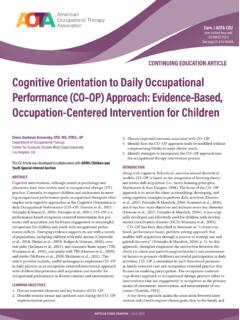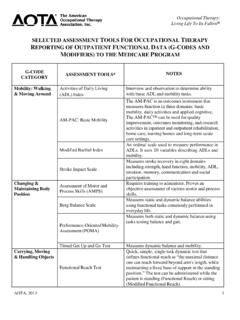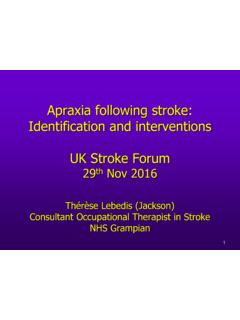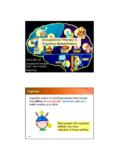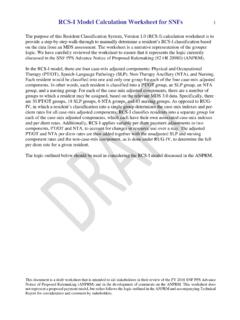Transcription of A Summary of Client Profiles for Case Study Projects
1 A Summary of Client Profiles for Case Study Projects Corbett Clinic Case # 1 - Teamwork Inter-Departmental Learning Module Client PROFILE - Megan - MVA Traumatic Brain Injury Megan is a 14 year-old girl who was involved in a vehicle MVA near Jasper one month ago. Megan was the passenger in the vehicle, which rolled at highway speed. Her 16 year-old boyfriend, Brent, was driving the car. She was not wearing her seat belt although Brent was wearing his seat belt. She displayed decorticate posturing at the scene of the accident. She was stabilized at the Jasper Hospital, orally intubated and airlifted to an acute care hospital in Edmonton. Upon admission, her Glasgow Coma Scale score was 5/10. Examination revealed right hemiparesis secondary to closed head injury with bifrontal (L>R) intracerebral hemorrhage and intraventricular hemorrhage.
2 She sustained multiple face lacerations. Megan remained in a coma in the intensive care unit (ICU) for 10 days. Two days after waking from her coma she required a tracheostomy due to bilateral atelectasis and consolidation in both lower lobes of her lungs. A gastrostomy feed tube was inserted two weeks later. Her Glasgow Coma Scale score improved to 14/15. Megan was transferred to a Rehabilitation Hospital one month after the accident. Megan and her parents had recently moved to Edmonton from Hinton. She was in Hinton for the weekend, against her parents better judgement, visiting her friends and boyfriend. Megan was a good student and was active in gymnastics, volleyball, soccer and horseback riding prior to her accident. Brent suffered only minor injuries from the crash and has visited Megan a few times in the hospital since the accident.
3 Megan s parents are very angry with Brent and feel that his inexperienced driving skills were the main cause of the accident. They are very worried about their daughter s future. Megan s parents have expressed concerns that she is not the same girl that she was before the accident. Megan is very concerned that people like her and is afraid that her friends and boyfriend will avoid her now that she has a brain injury. She says she would do anything to keep her friends. Since the accident, Megan has been intensely emotionally reactive, becoming easily angered, excited, depressed or anxious by little events or changes to her routine. Her parents describe the situation by saying, Everything is one extreme or the other with her now, there is no happy medium. You re either her best friend or she hates you. She is often impulsive, saying whatever is on her mind with no apparent thought for the social implications of what she says.
4 She also shows impulsivity in her actions leading them to worry about her safety. Since Megan has become more independent in using the wheeled walker, nursing staff have reported that she is wandering into other patients rooms and trying to get into bed with them. Megan s doctor feels that she may be demonstrating personality change due to a general medical condition with symptoms similar to borderline personality disorder. Megan s parents have expressed concerns that she is not the same girl she was before the accident. She is very concerned that people like her and is afraid that her friends and boyfriend will avoid her now that she has a brain injury. She says she would do anything to keep people from abandoning her. Since the accident Megan has been intensely emotionally reactive, 2becoming easily angered, excited, depressed or anxious by little events or changes to her routine.
5 Her parents describe the situation by saying, Everything is either at one extreme or the other with her now, there is no happy medium. You re either her best friend or she hates you. She is often impulsive, saying whatever is on her mind with no apparent though for the social implications of what she says. She also shows impulsivity in her actions leading them to worry about her safety. Megan s doctor feels that she may be demonstrating personality change due to a general medical condition with symptoms similar to borderline personality disorder. Megan - Summary of OT Assessment: Canadian Measure of occupational performance A COPM was conducted with Megan to help her identify and prioritize issues related to self-care, productivity and leisure. Her parents were also interviewed to determine their areas of concern for Megan.
6 Self-Care Megan indicated that she would like to become more independent in many areas of self-care including dressing, bathing, and grooming. She feels that her parents are babying her and believes that being able to do these self-care tasks independently will force them to see her as a teenager instead of a child. She also expressed a desire to be able to walk independently so she won t have to use a walker at school. Her parents expressed concerns about the transfers and home adaptations necessary for when Megan is discharged home. Productivity Both Megan and her parents rated returning to school as a priority. Megan would like to be able to complete her final year of junior high so that she can attend the prom with her boyfriend. Her parents expressed concerns about Megan s cognitive impairments interfering with her ability to keep up with her peers in a regular academic program.
7 Leisure Megan identified socialization as the area where she is most dissatisfied. She is feeling lonely and believes it will be difficult to make friends in Edmonton. Megan is very conscious of her scars and worries that her boyfriend won t love her anymore now that she s ugly and stupid! She adds that her parents are driving Brent away because they blame him for the accident. Megan s parents would like to find a social/leisure activity that Megan can participate in after discharge to give her a chance to make new friends. Functional Independence Measure (FIM) The FIM was done to assess Megan s level of independence in basic ADLs. In general Megan was able to complete the required tasks with supervision or minimal assistance.
8 Megan demonstrated difficulty with sequencing of tasks and struggled to remember two step directions. While Megan is physically able to do many of these tasks, there is concern as to her safety due to impairments in balance, coordination as well as her tendency to act impulsively and show poor judgement. Kohlman Evaluation of Living Skills (KELS) The KELS was administered to determine Megan s competence in basic living skills and to assess her overall ability to learn. Megan had difficulty with most of the items on this measure. She appeared to guess for most of her answers and was unable to provide an adequate 3explanation for her choices. When pressed for answers she either made up an answer or became frustrated and non-compliant. Megan shows great difficulty with tasks requiring problem solving or multiple steps.
9 General Impression Megan is motivated to attend the OT treatment sessions. She thinks the OT really listens to her and wants to know what is important to her. OT is the one area where she feels she is making significant progress and the improvement she sees are giving her hope that she will make a full recovery. 4 Case Study # 1 Megan - Discussion Questions Introduction/ general: 1) What is your role as an occupational therapist with this Client ? Stage #1: 1) Name, validate and prioritize occupational performance issues. 2) Where would you look for more information on your Client ? Stage #2: 1) Select theoretical approach(es), both generic and specific, clearly give a rationale for your choice(s). Stage #3: 1) Identify occupational performance components and environmental conditions 2) What are the areas you will want to assess?
10 3) List the standardized measures you might use to assess this Client . 4) What type of information do you hope to uncover with the assessments you have selected? Stage #4: 1) Identify Strengths and Resources 2) Write a short occupational Profile on the Client Stage #5: 1) How would you go about negotiating target outcomes with your Client ? 2) Write your negotiated targeted outcomes, goals and action plans in order of priority. 3) Choose one activity from the activities lab and complete a mini activity analysis, demonstrating its value as a therapeutic medium. Stage #6: 1) Megan s parents appear to be quite active, how would you incorporate them into you treatment plan? 2) Select two pieces of adaptive equipment from the ADL lab you would prescribe for Megan. Stage #7: 1) What criteria would you use to determine if your targeted outcome has been achieved?

